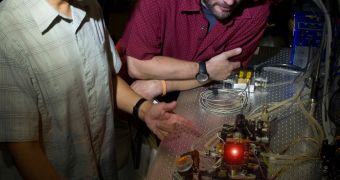Scientists at the NASA Goddard Space Flight Center (GSFC) are currently working on developing the world's first spaceborne sodium LIDAR (Light Detection and Ranging) instrument. The device will be used to study the mesosphere, a region of the atmosphere very prone to influences from both the Earth and the Sun.
The mesosphere stretches from 65 to 177 kilometers (40 to 110 miles) above our planet's surface, and it is influenced by both the atmospheric layers below and highly-charged particles emanating from the Sun. Experts refer to it as the area where the atmosphere meets the empty space.
One of its most interesting traits is that it features a lot of sodium, in addition to chemicals such as iron, magnesium, potassium and calcium. Ground-based sodium LIDAR devices have been used to measure sodium concentrations in the mesosphere for many years.
However, no such readings were ever recorded from space, a lack of data that is hampering researchers' understanding of small-scale mesosphere dynamics. The GSFC team hopes to address this issue with a new type of LIDAR device.
“We want to do this from space. We want to map the entire mesosphere by the fluorescence of sodium,” says the principal investigator of the GSFC LIDAR-development team, Diego Janches.
He argues that the new device is a logical next time to augment the data sent back to Earth by the NASA Thermosphere, Ionosphere, Mesosphere Energetics and Dynamics (TIMED) spacecraft. The team plans to test the finished instrument from aboard the International Space Station (ISS).
Unlike TIMED's Sounding of the Atmosphere using Broadband Emission Radiometry (SABER) instrument, which collects general data from all parts of the atmosphere once every 60 days, a spaceborne sodium LIDAR would collect a constant flow of data from a single point in the sky.
“Because of this, we get small-scale dynamics, which are the biggest unknowns. And they are important. They are believed to be the major driver of circulation in the upper atmosphere,” Janches say.
A deep study of the mesosphere could reveal how much of the global warming we are experiencing is caused by humans, and how much by natural atmospheric variability and solar influences.

 14 DAY TRIAL //
14 DAY TRIAL //